The iPad Air Review
by Anand Lal Shimpi on October 29, 2013 9:00 PM ESTiPhone to iPad: CPU Changes
Although the iPad Air uses the same A7 from the iPhone 5s (and M7 motion coprocessor), there are a few minor differences that do lead to better performance.
At a high level we’re still talking about two 64-bit Apple Cyclone cores with 128KB L1s (64KB I$ + 64KB D$) per core, a shared 1MB L2 cache and a 4MB L3 cache that services the entire SoC. Apple increased CPU frequency from 1.3GHz to 1.4GHz in the iPad Air, a mild increase but in line with what we’ve seen from previous iPad designs. That’s the first impact on performance - a 7.69% increase in CPU frequency.
The second impact on performance is something I only noticed while digging around under the hood of the A7. It seems like the implementation in the iPad Air can, for whatever reason, hold more instructions in flight (over 20% more) than the A7 in the iPhone 5s. It’s unclear to me whether the A7 in the iPad is configured any differently via firmware/microcode or if perhaps we’re looking at a slightly different revision of the core, but the delta was repeatable in my testing.
The third, and likely biggest change impacting the iPad Air’s implementation of the A7 is the additional thermal headroom afforded by the larger chassis. I’m not going to go into details on exactly what this next test does (unfortunately we’re going to occlude some of the low level work that we do in light of all of the benchmark cheating going on), but we’re looking at a curve of performance vs. time for a particularly power heavy mix of code. We’re running the same exact code on both the iPad Air and iPhone 5s here, the only real difference is the size of the chassis:
You can see the 5s throttles back its CPU frequency to about 1GHz after the 2 minute mark. The crazy thing is that until that point the 5s manages to run at full frequency without so much as a hiccup for two full minutes, running an incredibly power hungry task. Given that most iOS apps aren’t this power intensive for such a sustained period of time, iPhone 5s users should almost always see the A7 running at a full 1.3GHz. Pretty crazy.
The iPad Air by comparison shows much more controlled behavior. Early on in the test we see a 7.7% performance advantage, which lines up perfectly with the iPad Air’s 7.7% CPU frequency advantage. By the end of the test the iPhone 5s has throttled to 900MHz, while the iPad Air drops to around 1.2GHz. At this point the iPad Air’s performance advantage grows to almost 40%.
CPU Performance
I've gone through our standard set of cross-platform browser based benchmarks to place the iPad Air's performance in perspective. As I mentioned in our 5s review, I don't know that there are many (any?) applications on iOS 7 that can really take advantage of all the A7 has to offer. There's definitely a ton of headroom left in the design. What's particularly exciting is when the A7 ends up in n-1 or n-2 iOS devices and it becomes the minimum developer target going forward.
I won't go through all of the results here again, but it's safe to say that the iPad Air is the fastest ARM based tablet on the planet at this point.
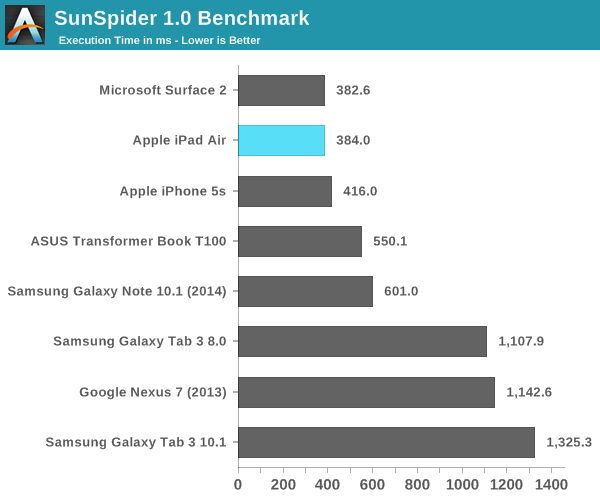
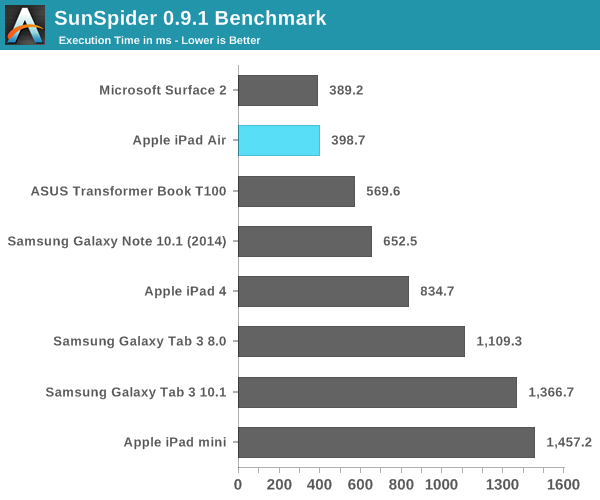
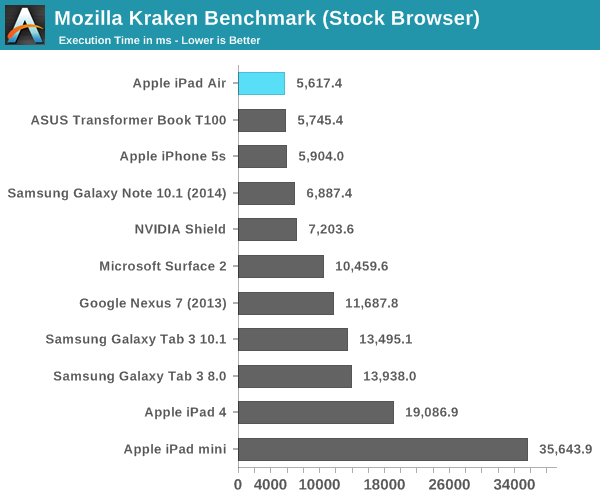
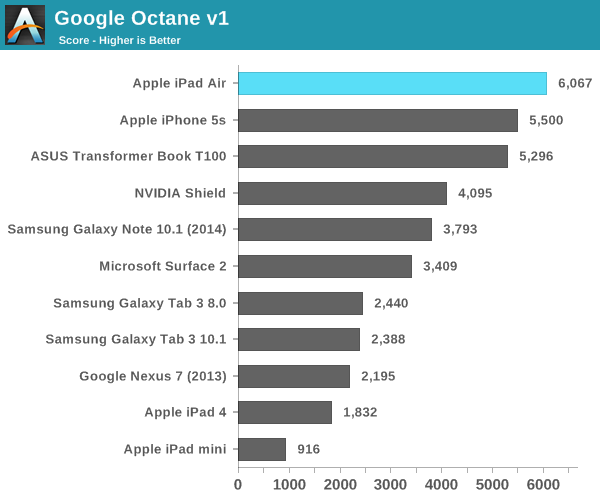
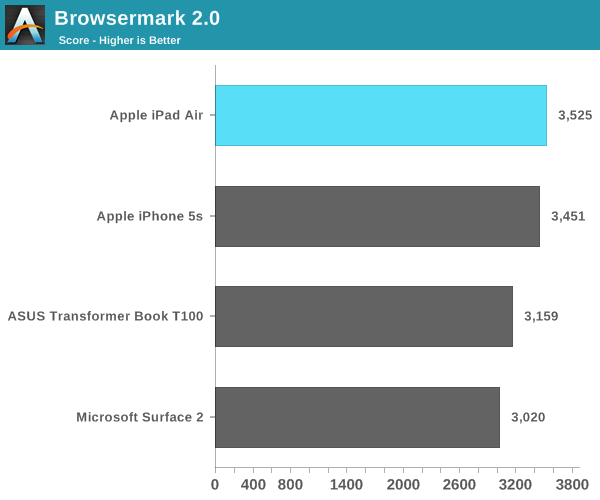

A7 Power Consumption
I’ll get to battery life in a bit, but I’ve been curious about the dynamic range of power consumption offered by Apple’s new A7 SoC. On the one hand we’re dealing with a lower power process (28nm vs. 32nm), but on the other hand Apple’s Cyclone cores can clearly draw more power given how beefy the architecture is this round. Apple frowns upon review sample dissection so I had to turn to a less scientific method of external platform level power measurement. The fidelity of the numbers here aren’t all that great but it’s better than nothing.
For the first test I measured platform power consumption during a Kraken run:
I purposely started measuring before the benchmark so I could get an idea of idle power consumption. The iPad Air consumes roughly 72% of the idle power as the iPad 4, both running at the same brightness. Here we’re not just seeing the A7’s advantages but also things like lower display power.
Focusing on the load portion of the measurement we see that both the new iPad and old iPad consume the same total power in this test. I suspect the A7 is drawing more power than the A6X, but it’s masked by a lower power display. Given how much faster the iPad Air is, Apple’s latest tablet features far lower overall task energy than the outgoing iPad 4. This is probably both the best case scenario for the iPad Air and the most likely case as well.
For kicks I wanted to see just how much power I could get the iPad Air to draw. Here I’m looking at platform power during our mini-power-virus test from above:
How’s that for dynamic range? Almost 12W running all out, but around half that in what we’d normally consider to be a stressful CPU test. I couldn’t get any actual applications/games on the iPad Air to behave like this so the results above are purely academic (for now). A quick run through GFXBench 2.7’s T-Rex HD test confirms that even pushing the GPU won’t hit these numbers. The max I saw running T-Rex offscreen was ~6W, and turning to an actual game (Infinity Blade 3) the iPad Air pulls less than 5W.


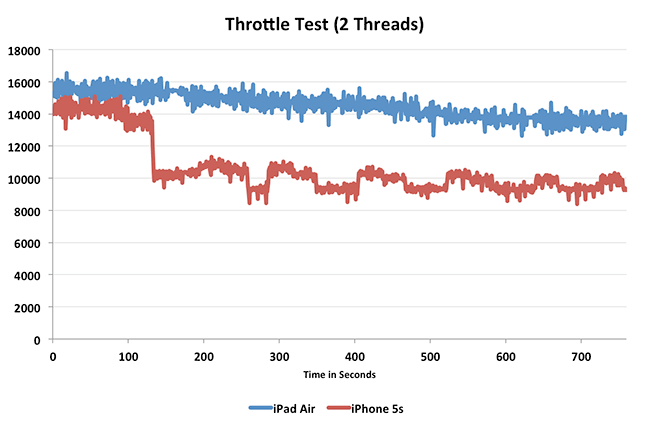
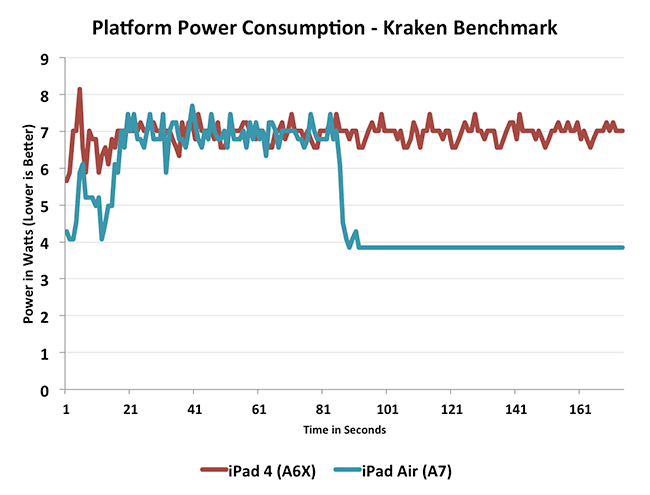
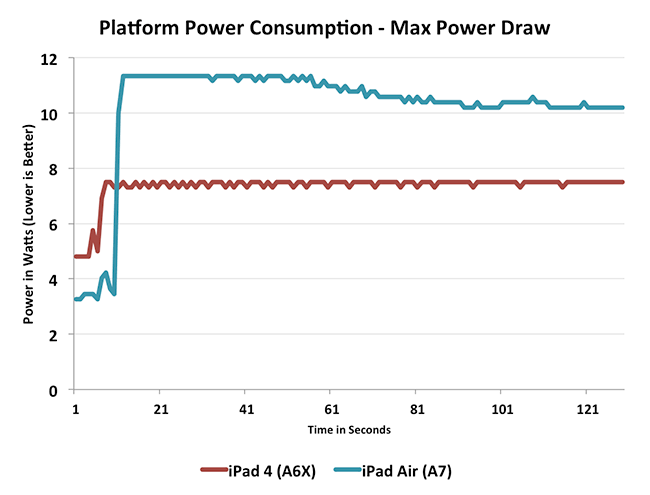








444 Comments
View All Comments
over9k - Tuesday, October 29, 2013 - link
Two paragraphs in and this is already better than all the other "reviews" out there.Beautyspin - Tuesday, October 29, 2013 - link
You should not really call any review by Anandtech of Apple products as reviews. They are homages paid to their shrine. This is a ritual with them..Drumsticks - Tuesday, October 29, 2013 - link
I always hear people complaining about bias here and elsewhere for apple products. But what exactly is the reason for that? The majority of the review is seriously objective - you can't argue that apple has some of the best performance in he game right now, and the best display to boot. He only thing rivaling it is probably the higher clocked Z3770, while Qualcomm will probably pass Apple's GPU early next year.as far as subjectivity goes, even if you don't like the design, the materials are solid. And it manages to be lighter than every other ten inch tablet on the market (and thinner) withot sacrificing battery life. The only subjective things I could possibly see are maybe the sound quality and the OS itself, of which he criticized a few times. Where does the bias come in?
Fleeb - Tuesday, October 29, 2013 - link
"and the best display to boot"We have yet to wait for the Kindle HDX review but it is lighter, packs more pixels and with 100%RGB gamut.
darwinosx - Wednesday, October 30, 2013 - link
Its lighter because it is cheap plastic. It is also a far more limited device. Really laughable to think it compares to an Air.dsumanik - Wednesday, October 30, 2013 - link
Read this review with a grain of salt. Anand lai shimpi is heavenly vested in apple stock, doing everything he can to boost the dismal situation.Thinner bezels and light weight do not hide the fact that functionally, this iPad is the same as the previous 2 generations.
Sent from my ipad3, which will be upgraded when apple actually updates the product line.
Here's some basic ideas mr cook:
Wireless charging
Fingerprint scanner
Thunderbolt sync or usb3
Haptic feedback
NFC
John2k13 - Wednesday, October 30, 2013 - link
You know what's disgusting about your comment, and those similar to yours? That you basically accuse the author of being a liar, a shill, and completely lacking in integrity- without a shred of evidence. I read the entire 10 page review, and it was incredibly detailed, precise, and well-written, something that would be obvious to most sane, rational, objective people."Anand lai shimpi is heavenly vested in apple stock, doing everything he can to boost the dismal situation."
First of all, what "dismal situation"? Apple stock is up around $130 from a few months ago, or almost a third. Hardly "dismal". Also, do you think a single review from a website visited primarily by tech geeks is going to have any fucking effect on the stock? I mean, are you for real? Don't assume the author holds the same amount of ignorant stupidity that you apparently do, to think for a second this review would have a snowball's chance in hell in affecting stock. You clearly know nothing about how the financial market works.
"Thinner bezels and light weight do not hide the fact that functionally, this iPad is the same as the previous 2 generations."
Functionality on a tablet is primarily based on software, and the iPad has 475,000+ optimized apps which are getting more powerful all the time. The hardware simply enables better software. A tablet is basically a blank slate for the software, and better hardware helps in enabling better software. Every single aspect of this iPad is improved, so yes, it is more "functional". That list you made, though, is pretty ridiculous, and obviously a desperate attempt to list anything you can think of that the iPad doesn't have and pretend its significant.
Wireless charging- why? This makes the device more functional, how?
Fingerprint scanner- Wow, brilliant "idea". You probably mocked touch ID when it appeared on the 5S. Again, this would be nice to have I guess, but in no way impedes "functionality" of the tablet.
Thunderbolt sync or usb3- I have no idea what "thunderbolt sync" means, and its pretty ridiculous you're harping on a USB3 port. It will never happen, nor should it.
Haptic feedback- Utterly useless gimmick, but heym why not, right?
NFC- I have NFC on my Nexus 4, and not ONCE have I even run into an opportunity or a reason to use it. But yeah, I'm sure you honestly think it's needed or useful on an iPad. Again, another meaningless bulletpoint you were desperate to add mindlessly.
Next time you want to baselessly accuse an author of being a liar, a shill, a sellout, and having no honesty or integrity, try to make a coherent post that actually contains some intelligent, well thought out information. Otherwise, by attacking the author you just embarrass yourself as you did now. Grow up.
ABR - Wednesday, October 30, 2013 - link
Actually thunderbolt sync is one of the changes I'm really waiting for. Have you ever tried restoring even a 16GB iPad over USB? Slow agony. I can't even imagine what someone w/a 64 or 128GB model must go through. Even ordinary everyday syncs are far slower than what they could or should be.Howard Ellacott - Wednesday, October 30, 2013 - link
You clearly don't realise what thunderbolt is, which is why that's such a stupid suggestion. Yes, faster syncs would be amazing, and restoring a 64gb iPhone is a right pain, but thunderbolt isn't the way.Kristian Vättö - Wednesday, October 30, 2013 - link
USB 2.0 isn't the real bottleneck there, it's NAND. Most eMMC solutions can't even saturate the USB 2.0 link with sequential writes, so Thunderbolt or USB 3.0 would do absolutely.